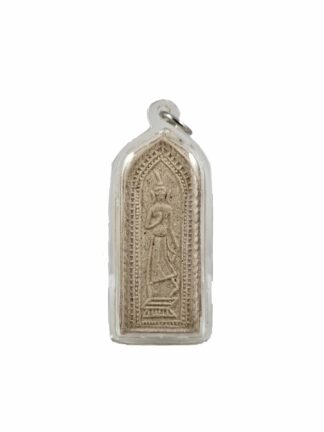Phra Leela
Phra Leela, known as the “Buddha in the Walking Posture,” is a distinct and revered representation in Thai Buddhist art. Unlike the more common meditative and static postures, the Phra Leela captures the Buddha in a dynamic moment, as he takes a stride. This unique depiction symbolizes the Buddha’s return from the Tavatimsa Heaven. There, he had journeyed to preach the Abhidhamma Pitaka to his mother, Queen Maya, following her rebirth in that realm.
In this portrayal, the Buddha’s right foot is assertively set forward, its heel slightly raised off the ground, reflecting his purpose and determination. His raised hand, typically presented in the gesture known as Abhaya Mudra, offers blessings and reassurance, while his other hand rests calmly by his side. There is a profound serenity evident in his half-closed eyes, suggesting a state of meditation even as he walks. This level of detailing extends to his monastic robes, which are often intricately designed.
Some depictions further accentuate the sanctity of this moment with an ornate seven-tiered umbrella placed above him, symbolizing spiritual royalty. This image of the Walking Buddha finds its origins in the Sukhothai period, between 1238 and 1438 AD, a time when Thai Buddhist art flourished, emphasizing elegance, grace, and fluidity. Today, the Phra Leela statues and amulets hold immense value, not only for their spiritual significance but also as cherished emblems of Thai cultural heritage. For many, this portrayal of the Walking Buddha is more than just art; it embodies the Buddha’s unwavering commitment to sharing his teachings.
Showing all 10 results
-

Phra Leela
$58 Add to cart -

Phra Leela
$95 Add to cart -

Phra Leela
$147 Add to cart -

Phra Leela
$738 Add to cart -

Phra Leela
$1,330 Add to cart -

Phra Leela
$147 Add to cart -

Phra Leela
$2,070 Add to cart -

Phra Leela
$95 Add to cart -

Phra Leela
$132 Add to cart -

Phra Leela
$5,916 Add to cart
Showing all 10 results










